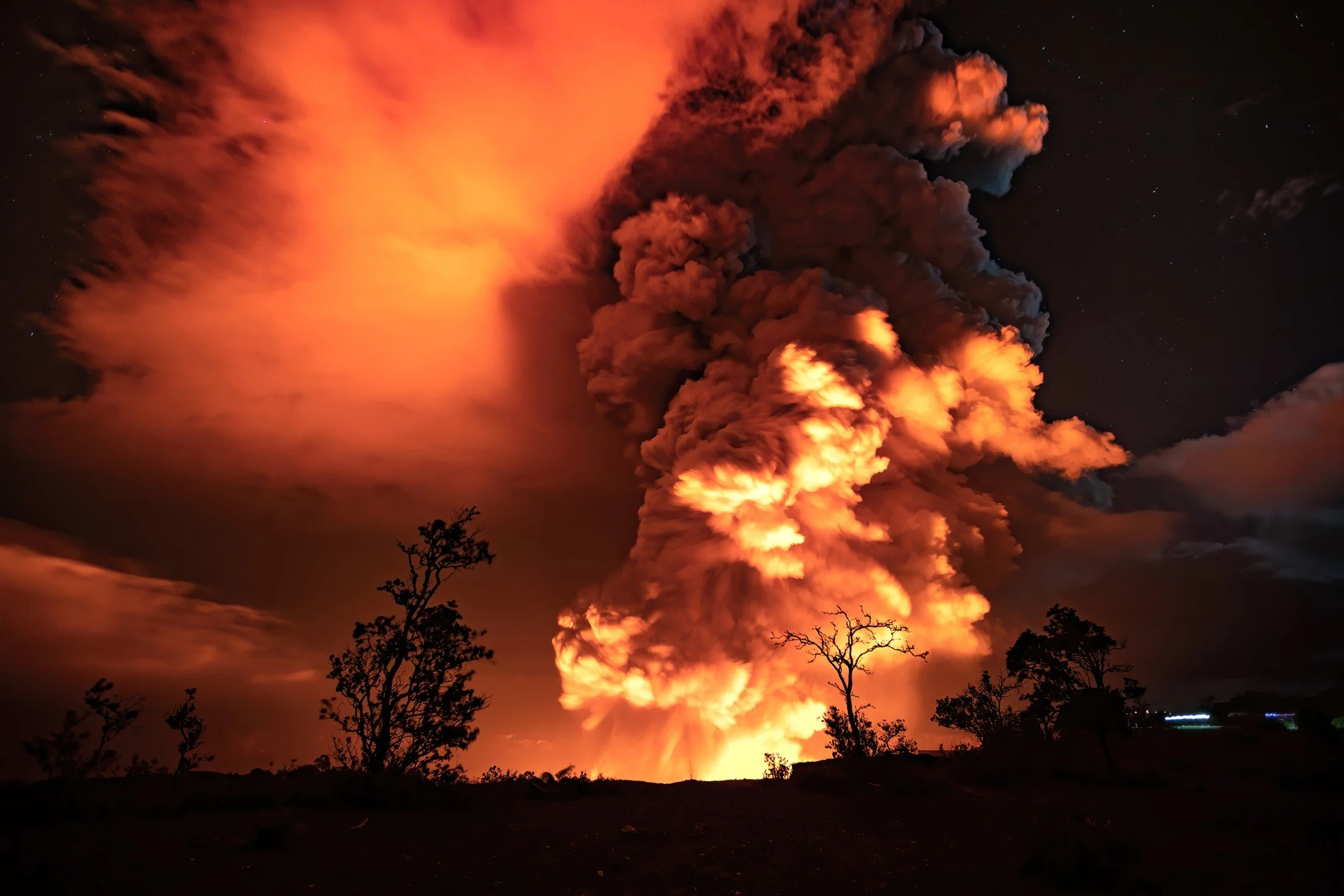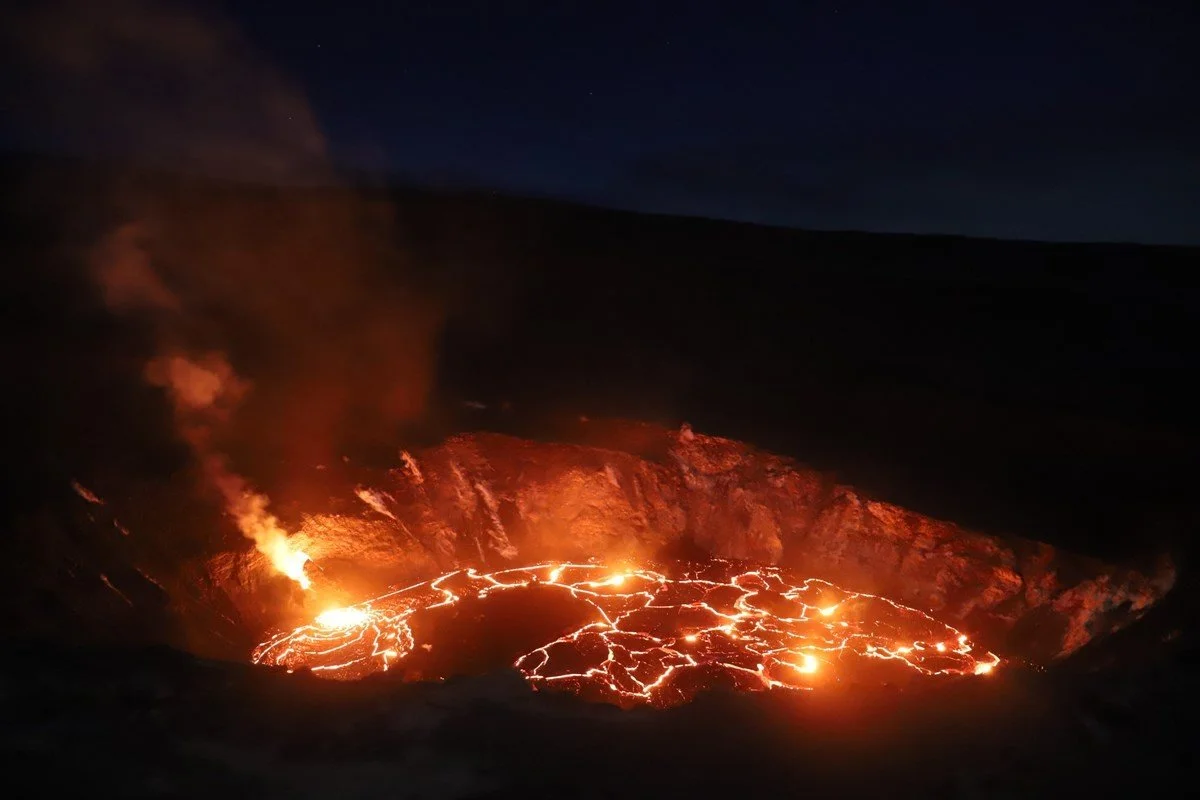Optimizing the Brain: Interacting with Nature during the 2020-2021 Summit Eruption at HALEMAʻUMAʻU
Driving in Hawaii from Hilo to Pahala on a dark night was a country road experience. Two narrow lanes wind toward Volcanoes National Park and south 30 miles to the beautiful countryside that produces some of the best coffee in the world.
To see the clouds glowing red and orange with a special vibrance as I passed was my first clue that something was a little different. It was Tuesday, December 21, 2020. The year 2020 has been an epic collection of uncertainty and I was ending it in a voyage to one of my favorite places on earth.
I soon received a ding, alerting me that the water lake that existed at the summit of Kilauea had boiled away and three vents in the wall of Haleuma’uma’u crater had cascaded lava flows into a growing lake of lava. By January 6, the lava lake would be 630 feet deep. Coming from the arid climate of Colorado, I was now within sight of the largest humidifier available at the moment. Yet having lived in the islands during several eruptions, I have adopted the peace and reverence of co-existing with Pele, the Goddess of Hawaii’s volcanoes. Hawaiians have long revered her as the personification of the natural phenomenon of volcanic activity.
I am blessed with a deeper than average grasp of geology, I suppose. From seeing road cuts in the Rocky Mountains as a young child (explained by my grandfather, a geologist himself), to the classroom version explained by my professors at the University of North Carolina, and by then teaching the “Rocks for Jocks” class to my own students, I have learned the basic science of the molten world that lives beneath the crust of our earth.
But I have gone beyond that to a deeper understanding of the connection with the land we all have and often ignore. The rapid pace of life in the 21st century often severs that tie. We spend days with our heads down working over computers, swiping on our phones, and checking email. We often cut our tie to the glory just above our heads and beneath our feet.
We can reconnect simply by looking up, no signal is needed. Taking the briefest moments to interrupt our craving for more digital dopamine to expand our view to the deep richness of nature outside our constructed boxes can yield the freedom and joy we have forgotten to ingest.
The habit of connecting with the earth to enrich our minds is worth investing time in. Connection is deeply essential to human well-being and activating the relational circuitry is deemed by neuroscientists as one of the essential cognitive activities to include in your daily mental diet. This connection isn’t just with other humans. It is with the ever-expanding sphere of our environment. Ignoring her is deeply disrespectful of her gifts, and a loss that we underestimate. We are limiting our minds by depriving ourselves of a primal source of connection.
Hawaiians have long understood this about the volcano and call her “Tutu” which is an affectionate term for a grandparent. They do not resent her asserting her presence. Herb Kawainui Kane, the author of a book about Pele Tutu, or Pele-’ai-honua, recognizes this in a collection of beautiful artwork, history, folk tales, and personal experiences. He is a renowned artist that was inspired to dig deep into this familial and personal connection when he was asked to participate in a project. He was to create a series of paintings for photo murals at the Thomas A. Jaggar Museum at the Hawai’i Volcanoes National Park. He quotes that “science alone could not express the human experience of the volcanoes. Pele personified that experience.”
He is not alone in his attitude, and this is not just a platitude. When lava destroyed part of the village of Kalapana in December 1986, a Hawaiian resident, in the local dialect was quoted as saying, “I love my home; live here all my life, and my family for generations. But if Tutu like take it, it’s her land.” If you can say this, while loading your possessions into a truck while lava consumes the house you were born in, I would say this is a fairly genuine belief.
So I wonder... how have we come to disconnect from the land that we take such fierce ownership of? Why have so many of us lost that respect and relationship with the land that truly nurtures us and defines our existence on earth?
It was with these questions that I thought deeply about how thoroughly we are depriving our own capabilities with this mindset. Children intuitively find nurture in nature, as I quickly recognized when my infant son could be instantly soothed by stepping outside. I thought of the many hikes and camping experiences in my own childhood with gratitude, which is revitalized every time I take intentional notice of the expansive, breathtaking landscapes of Wyoming and Colorado and the distinct roping of black igneous rock that has cooled in swathes down into the waters of the Pacific.
My breathing eases, my shoulders drop, and my soul expands. My mind soars and I wonder once again why I don’t do this more often. How about you?
Mahalo for taking the time to read my thoughts!
I urge you to create your own journey to a more Agile Intellect and spend some time connecting with nature.
Your mind won't mind. It will simply absorb this gift and give you many gifts to harvest in return.
Aloha and a hui hou!
Agile Intellect is the namesake for a reason.
I founded this company with the volatility of the world in mind.
A brain-healthy lifestyle creates measurable transformation.
This 8 Key Framework creates the scaffold
Habit hacks make it sticky
The Spiral Method allows this lifestyle to grow over time.
Because the power of the mind is limitless when you simply begin the journey!
Want to learn more or need a personal guide?
A limited number of coaching spots are available.
It would be my honor to help.
For a free discovery call, click here.
Subscribe here for more tips on how to foster your mind.





